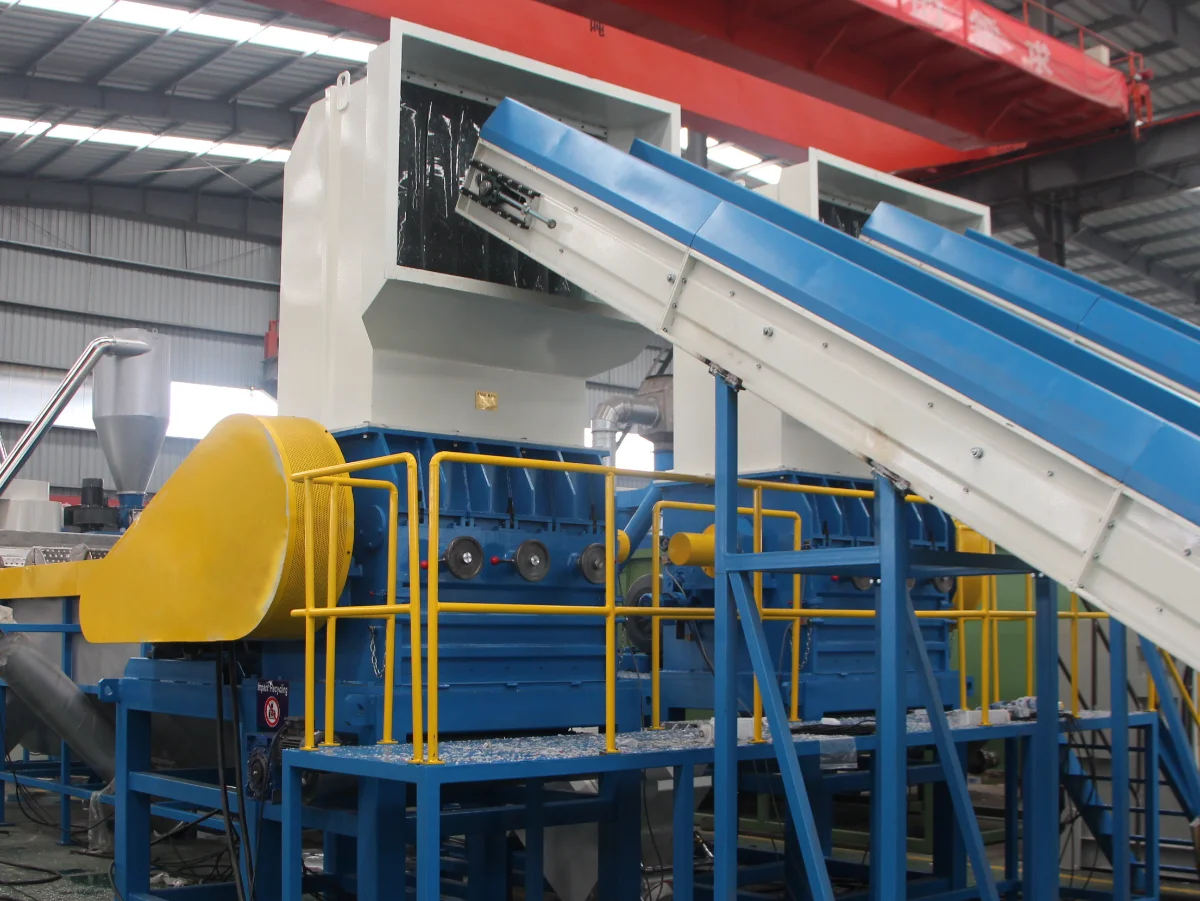Mokre maszyny do mielenia plastiku: Kompleksowe przewodnik dla operacji recyklingowych
Mokre maszyny do mielenia plastiku są fundamentem nowoczesnych, efektywnych zakładów recyklingowych. Wprowadzanie wody bezpośrednio do procesu zmniejszania rozmiaru tych maszyn nie tylko granuluje plastik, ale jednocześnie przedmywa materiały, przedłuża żywotność urządzeń i tworzy bezpieczniejsze środowisko pracy. Dla profesjonalistów od recyklingu i menedżerów zakładów, zrozumienie mechaniki, korzyści i zastosowań tej technologii jest kluczowe dla optymalizacji przepustowości, poprawy jakości recyklatu i zwiększenia zysków.
Ten przewodnik dostarcza szczegółowego omówienia mokrych mielarkach plastiku, ich zasad działania, kluczowych różnic między mokrym a suchym mielaniem oraz praktycznej porady dotyczącej wyboru i utrzymania odpowiedniego sprzętu dla Twoich specyficznych potrzeb. Zbadamy, jak integracja wysokiej jakości mokrego granulatora może przekształcić Twoją linię recyklingową.

Czym dokładnie jest maszyna do mokrego mielenia plastiku?
Maszyna do mokrego mielenia plastiku, często nazywana mokrym granulatorem, to urządzenie do zmniejszania rozmiaru, które używa wysokiego prędkości wirnika z ostrymi nożami do cięcia dużych elementów plastikowych na małe, jednolite płatki lub regrind. Jej charakterystyczną cechą jest ciągłe wtryskiwanie wody do komory cięcia podczas działania.
Woda pełni kilka kluczowych funkcji:
- Chłodzenie: Aktywnie chłodzi wirnik, noże i sam materiał, zapobiegając jego topnieniu przez tarcie. Jest to szczególnie ważne dla plastików o niskiej temperaturze topnienia, takich jak folia LDPE.
- Czyszczenie: Przepływ wody działa jako potężny środek czyszczący, zmywając z powierzchni plastiku zanieczyszczenia takie jak brud, piasek, etykiety papierowe i resztki jedzenia.
- Smarowanie: Zbiera olej, który smaruje działanie cięcia, zmniejszając tarcie i zużycie noży.
- Tłumienie pyłu: Woda łapie drobne cząstki plastiku i pył, zapobiegając ich unoszeniu się w powietrzu i tworząc czystsze, bezpieczniejsze środowisko dla operatorów.
W wyniku tego powstaje papka z czystych płatków plastiku i zanieczyszczonej wody, która następnie jest oddzielona. Czyste płatki mogą przejść do następnego etapu procesu recyklingu, takiego jak frakcjonator lub zbiornik do flotacji, z dużym przewagą pod względem czystości.
Proces mielenia mokrego: Podział krok po kroku
Zrozumienie strumienia operacyjnego mokrego mielarki plastikowej pomaga wyjaśnić jej wartość w szerszym systemie recyklingu. Chociaż projekty różnią się między producentami, podstawowy proces pozostaje taki sam.
- Podawanie materiału: Wstępne rozdrobnienie lub całe przedmioty z plastiku, takie jak butelki PET lub wiadra HDPE, są dostarczane do zbiornika granulatora, zazwyczaj za pomocą taśmy transportowej.
- Wstrzyknięcie wody: Gdy materiał wchodzi do komory cięcia, system dysz ciągło rozpyla wodę na plastik i części tnące. Ilość wody i ciśnienie mogą być często dostosowywane w zależności od typu materiału i poziomu zanieczyszczenia.
- Redukcja rozmiaru (granulacja): Ciężki wałeczek obracający się z dużą prędkością (zwykle 400-600 obrotów na minutę) zmusza plastik do kontaktu z stałą ławką noży. Działanie tnące noży wałeczkowych na ławkę noży tną materiał na mniejsze kawałki.
- Filtracja i Klasyfikacja: Komora tnąca jest otoczona perforowaną siatką. Materiał pozostaje wewnątrz komory, cięty ciągło, aż staje się wystarczająco mały, aby przejść przez otwory w siatce. Rozmiar otworów w siatce określa ostateczny wymiar płatka.
- Wypisać: Mieszanka płatków plastikowych o odpowiednim rozmiarze i wody opuszcza maszynę przez otwór wyjściowy na dole. Ta mieszanka jest następnie transportowana, często za pomocą łańcucha transportowego lub pompy, do następnego urządzenia w linii myjącej.
Mokre mielienie kontra suche mielenie: Bezpośrednie porównanie
Dla każdej operacji recyklingu, wybór między mokrym a suchym granulatorem jest znaczący. Suchy granulator działa bez wody, polegając na zasysaniu powietrza do evacuacji materiału i kontroli pyłu. Oto, jak porównują się one w kluczowych parametrach operacyjnych:
| Funkcja | Maszyna do mokrego mielenia plastiku | Maszyna do suchego mielenia plastiku |
|---|---|---|
| Efektywność czyszczenia | Wysoka. Zintegrowany etap przedmycia, skutecznie usuwający zanieczyszczenia powierzchniowe, papier i kleje. | Niska. Zanieczyszczenia są mielone razem z plastikiem, co wymaga bardziej intensywnego czyszczenia w dalszej części procesu. |
| Kontrola Pyłu | Woda praktycznie eliminuje prawie wszystkie pyły, poprawiając jakość powietrza i bezpieczeństwo w miejscu pracy. | Wymaga oddzielnego, energochłonnego systemu odwadniania i filtracji powietrza do zarządzania pyłem. |
| Żywotność ostrza | Dłuższy. Woda chłodzi i smaruje ostrza, zmniejszając zużycie spowodowane przez ciepło i tarcie. Ścieralne materiały, takie jak piasek, są zmywane, zapobiegając przedwczesnemu zmatowieniu. | Krótszy. Ostrza są narażone na wyższe temperatury i większe tarcie, co wymaga częstszego szlifowania lub wymiany. |
| Zużycie energii | Może prowadzić do niższego ogólnego zużycia energii systemu, ponieważ zmniejsza obciążenie urządzeń myjących po stronie dolnej. | Sam granulator może zużywać nieco mniej energii, ale ogólny zużycie energii systemu jest wyższe ze względu na potrzebę silnych systemów zbierania pyłu. |
| Idealne zastosowania | Post-konsumpcyjne plastiki (butelki PET, pojemniki HDPE), folie rolnicze i inne zanieczyszczone materiały. | Czyste, wewnętrzne odpady przemysłowe (np. odlewki z wtryskiwarki, rurki), gdzie zanieczyszczenie nie stanowi problemu. |
| Konserwacja | Wymaga zarządzania systemem wodnym (filtry, pompy). Mniej częste konserwowanie ostrzy. | Wymaga regularnego czyszczenia filtrów zbierania pyłu. Częstsze konserwowanie ostrzy. |
Kluczowe Zalety Integracji Mokrego Zgniatania w Procesie Pracy
Wprowadzenie mokrych maszyn do zgniatania plastiku przynosi namocne korzyści, które bezpośrednio wpływają na efektywność operacyjną i jakość końcowego produktu. Stowarzyszenie Recyklerów Plastiku (APR) ustanawia rygorystyczne wytyczne dotyczące jakości materiałów recyklingowych, a mokre zgniatanie pomaga spełnić te standardy.
Doskonałe usuwanie zanieczyszczeń
Dla plastików pozużytkowych zanieczyszczenia są głównym wyzwaniem. Mokre zgniatanie podejmuje to wyzwanie bezpośrednio. Silny, ciągły przepływ wody rozluźnia brud, pozostałe płyny i resztki jedzenia. Pomaga również oddzielić papier i kleje od etykiet, co jest kluczowym krokiem w produkcji czystych flaków PET do recyklingu butelka w butelkę.
Zwiększona Longevitasz Noży i Maszyn
Koszty operacyjne granulatora są znacząco wpływowane przez harmonogram konserwacji noży. Dzięki ciągłemu chłodzeniu powierzchni cięcych mokry zgniatacz zapobiega utracie twardości i wytrzymałości noży przez nadmierny ciepło. To przekłada się na dłuższe interwały między szlifowaniem i wymianą, zmniejszając czas przestoju i koszty części zamiennych. Efekt smarowania również minimalizuje nacisk na łożyska i zestaw wirnika.
Zwiększone Bezpieczeństwo Pracy i Zgodność z Przepisami Środowiskowymi
Pył z tworzyw sztucznych jest poważnym zagrożeniem zawodowym. Może być drażniącym dla dróg oddechowych i, w wysokich stężeniach, wybuchowym. Jak zauważyła Administracja Bezpieczeństwa i Zdrowia w Pracy (OSHA), zarządzanie wybuchowymi pyłami jest kluczowym priorytetem bezpieczeństwa. Mokre zgniatanie efektywnie eliminuje pył powietrzny u źródła, tworząc znacznie bezpieczniejsze środowisko i upraszczając zgodność z przepisami dotyczącymi jakości powietrza.
Poprawa Jakości i Wartości Recyklingowych Flaków
Ostatecznym celem recyklingu jest produkcja wysokiej jakości surowca. Czyste flaki mają wyższą cenę na rynku. Dzięki agresywnemu przedmyciu, mokre zgniatacze produkują flaki znacznie czystsze niż te uzyskane z procesu suchego. To zmniejsza obciążenie kolejnych etapów mycia, pozwalając im być bardziej efektywnymi i prowadząc do końcowego produktu o niższym poziomie zanieczyszczeń.
Kluczowe Zastosowania i Właściwe Materiały Plastikowe
Mokre maszyny do mielenia plastiku są wszechstronne, ale wyróżniają się w konkretnych zastosowaniach, gdzie ich możliwości czyszczenia przynoszą największą wartość.
- Butelki PET: To jest główne zastosowanie. Mokre mielarki efektywnie usuwają etykiety papierowe, klej i resztki napojów, produkując czyste łuski gotowe do zanurzenia w zbiornikach do flotacji.
- Pojemniki z HDPE: Butelki mleczne, butelki detergentowe i inne pojemniki z HDPE są przetwarzane efektywnie. Woda pomaga usunąć resztki produktu i brud.
- Zanieczyszczone folie z tworzywa sztucznego: Folie rolnicze (folie mulczowe, pokrycia szklarniowe) są często bardzo brudne. Mokre mielenie zapewnia początkową, agresywną czyszczenie potrzebne do ich przetworzenia.
- Mieszane tworzywa sztuczne sztywne: Bale mieszanych plastików pozużytkowych ze zbiorów ulicznych korzystają znacznie z zintegrowanego procesu czyszczenia.
Na Maszyna energetyczna, Projektujemy nasze urządzenia tak, aby radziły sobie z najtrudniejszymi materiałami, zapewniając niezawodną pracę w szerokim zakresie wymagających zastosowań.
Wybór odpowiedniej mokrej mielarki do Twoich potrzeb
Wybór odpowiedniej maszyny wymaga starannego przeanalizowania Twoich specyficznych wymagań operacyjnych. Weź pod uwagę te czynniki:
- Przepustowość: Ile materiału musisz przetwarzać na godzinę (kg/h lub lbs/h)? Wybierz maszynę o pojemności znacznie przewyższającej Twoje obecne potrzeby, aby umożliwić przyszły rozwój.
- Materiał wejściowy: Rodzaj, rozmiar i poziom zanieczyszczenia Twoich odpadów z tworzyw sztucznych? Szczerze zanieczyszczone lub duże materiały mogą wymagać maszyny z większym komorą cięcia i bardziej solidnym wirnikiem.
- Pożądany rozmiar kawałków: Ostateczny rozmiar kawałków jest określany przez siatkę. Upewnij się, że producent może dostarczyć siatki z odpowiednim średnicą otworów zgodną z Twoimi docelowymi specyfikacjami.
- Moc silnika: Silnik (mierzony w KM lub kW) musi być wystarczająco mocny, aby radzić sobie z Twoimi najtrudniejszymi materiałami bez zatrzymywania się. Maszyny o niskiej mocy prowadzą do niskiego przepływu i częstych zatorów.
- Konstrukcja i wytrzymałość: Szukaj maszyn wykonanych z solidnej, odpornej na ścieranie stali. Komora cięcia i wirnik powinny być zaprojektowane tak, aby umożliwić łatwy dostęp do ułatwienia zmiany noży i czyszczenia.
Zarządzanie i najlepsze praktyki operacyjne dla maksymalnej wydajności:
Aby maksymalizować trwałość i wydajność Twojego mokrego mielarki plastikowej, stały harmonogram konserwacji jest nie do negocjowania.
- Codzienne kontrole: Przed uruchomieniem wizualnie sprawdź komorę cięcia pod kątem jakichkolwiek obcych obiektów (np. metalu), które mogą uszkodzić noże. Sprawdź na obecność wycieków wody.
- Konserwacja ostrza: Regularnie sprawdzaj noże pod kątem zużycia i uszkodzeń. Obracaj i szlifuj je zgodnie z zaleceniami producenta. Utrzymywanie precyzyjnej przestrzeni między nożami jest kluczowe dla czystego, efektywnego cięcia.
- Czyszczenie siatki: Upewnij się, że siatka jest wolna od zatorów. Zatkane siatki zmniejszają wydajność i mogą prowadzić do przegrzania materiału wewnątrz komory.
- Smarowanie łożysk: Zgodnie z zalecanym harmonogramem smarowania łożysk wirnika zapobiegaj wczesnemu ich uszkodzeniu. Słuchaj pojawiających się nieprzyjemnych dźwięków, które mogą wskazywać na problem z łożyskami.
- Zarządzanie systemem wodnym: Regularnie sprawdzaj i czyszcz filtry wlotowe wody, aby zapewnić stały przepływ i ciśnienie. Jakość wody używanej wpływa zarówno na efektywność czyszczenia, jak i zużycie maszyny.
Przez wdrażanie tych praktyk upewnisz, że Twoje urządzenie działa w najlepszym stanie. Nasz zespół może dostarczyć dostosowaną pomoc i wsparcie w utrzymaniu zaawansowanych mokrych mielarek plastikowych dla długoterminowego, bezproblemowego działania.
Zobacz specyfikacje mokrej mielarki plastikowejPrzemysł recyklingu plastiku nieustannie ewoluuje, aby sprostać rosnącym zapotrzebowaniom na wysokiej jakości przetworzone materiały. Zgodnie z Agencją Ochrony Środowiska Stanów Zjednoczonych (EPA), wskaźnik recyklingu plastiku pozostaje kluczowym obszarem do poprawy, co czyni efektywną technologię przetwarzania bardziej ważną niż kiedykolwiek. (Źródło: U.S. EPA). Mokre mielarki plastikowe są bezpośrednią odpowiedzią na to wyzwanie, oferując niezawodny i efektywny sposób przetwarzania zanieczyszczonych odpadów z tworzyw sztucznych w cenną surowicę.



